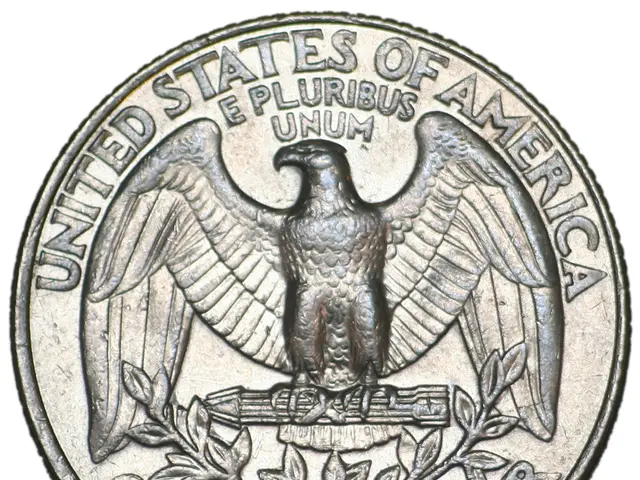The Battle for Texas's "Wall Street" Heats Up
What's the Potential Competition Scenario if a Texas Stock Exchange Emerges in the Market Dominated by NYSE and Nasdaq?
The race to secure a piece of the lucrative Wall Street market is in full swing, with Texas-based stock exchanges looking to dethrone the NYSE and Nasdaq duopoly. With billions of dollars in potential listing fees up for grabs, competition is fierce, and Texas's booming economy is providing the perfect battleground.
NYSE Texas, launched in Dallas in March 2025, snagged Trump Media and Technology Group Corp. (DJT) as their first listing, while the Texas Stock Exchange (TXSE) has secured $161 million in backing from financial giants like BlackRock, Inc. (BLK).
According to Bülent Temel, professor of economics at the University of Texas at San Antonio, "Texas's $2.7 trillion economy is on the rise, making it a highly attractive destination for companies seeking to go public and accelerate their growth. Given the state's common culture that embraces localism, getting listed on a Texas exchange would likely be these companies' first choice."
Challenging the NYSE/Nasdaq Duopoly
The last regional exchanges were swept away by consolidation between 2006 and 2009, marking the end of an era for U.S. stock exchanges. Fast forward to 2025, andTexas is poised to shake up the status quo. The state has attracted hundreds of major companies with its low taxes, looser regulations, and vibrant economy, including moves by Tesla (TSLA), Oracle Corp. (ORCL), and Chevron Corporation (CVX).
As traditional exchanges face mounting competition from alternative trading systems, the stage is set for TXSE to capture a significant portion of the market. Off-exchange trading venues now account for 51% of U.S. equities volume, compared to 18% for NYSE and 14% for Nasdaq. This shift largely stems from the rise of dark pools, payment-for-order-flow arrangements, and trade matching among large institutional investors.
The Road Ahead for TXSE and NYSE Texas
In January 2025, TXSE filed its Form 1 registration with the U.S. Securities and Exchange Commission, marking the beginning of the regulatory approval process. NYSE Texas, benefiting from regulatory approvals and existing infrastructure as part of Intercontinental Exchange Inc. (ICE), hit the ground running, giving it immediate global recognition and existing relationships with listed companies.
While TXSE faces the challenge of building from scratch, its backers see this as an opportunity to introduce more efficient systems without the constraints of legacy systems. One notable difference between the two exchanges lies in their listing standards: NYSE Texas follows its parent company's established criteria, while TXSE plans to institute significantly stricter requirements, aiming for quality over quantity.
Dallas: A Rising Financial Hub
Dallas now ranks as the second-largest financial hub in the U.S., offering a strategic location for both TXSE and NYSE Texas to tap into a vast and growing client base. The southeastern U.S., TXSE's primary market, is home to over 1,500 publicly traded companies and more than 5,200 private equity-backed firms, many of which are eager for public market access.
According to Temel, the social psychology that surrounds Texas's common culture will likely drive increasing numbers of Texans to invest in stocks using their local exchanges, while the rising average discretionary income in the state signals a promising future for the new exchanges in Dallas.
In essence, the rise of the TXSE as a viable competitor to NYSE and Nasdaq is rooted in Texas's corporate law reforms that make the state a business-friendly jurisdiction, significant tax exemptions that lower costs for stock exchanges and listed companies, and a growing Texas economy that offers a fertile ground for financial market activity. With legislative support from major market players like Nasdaq and a booming regional economy, TXSE represents a formidable challenge to the incumbent exchanges.
- The Texas Stock Exchange (TXSE) is planning to institute significantly stricter requirements for listings, aiming for quality over quantity, in contrast to the criteria used by NYSE Texas.
- Texas's economy, with its low taxes and looser regulations, has attracted companies like Tesla, Oracle Corp., and Chevron Corporation, challenging the NYSE/Nasdaq duopoly.
- Off-exchange trading venues now account for 51% of U.S. equities volume, while NYSE and Nasdaq account for 18% and 14% respectively, signaling a shift stemming from the rise of dark pools, payment-for-order-flow arrangements, and trade matching among large institutional investors.
- Texas-based stock exchanges, like NYSE Texas and the Texas Stock Exchange, are seeking to dethrone the NYSE and Nasdaq duopoly, with Dallas emerging as a rising financial hub due to its attractive business environment and growing client base.






